- Electric and Telecom Plans Free
- Fire and Emergency Plans Free
- Floor Plans Free
- Plant Layout Plans Free
- School and Training Plans Free
- Seating Plans Free
- Security and Access Plans Free
- Site Plans Free
- Sport Field Plans Free
- Cafe and Restaurant Floor Plans $25
- Gym and Spa Area Plans $49
- HVAC Plans $49
- Landscape & Garden $49
- Office Layout Plans $25
- Plumbing and Piping Plans $49
- Reflected Ceiling Plans $49
- Tilt and Turn Windows $25
- Agriculture Infographics $49
- Economy Infographics $25
- Education Infographics $25
- Energy Industry Infographics $25
- Financial Infographics $25
- Green Energy $25
- Management Infographics $25
- Marketing Infographics $25
- Mass Media Infographics $25
- Oil and Gas $25
- Politics Infographics $25
- Travel Infographics $25
- Business Process Diagrams Free
- Business Process Mapping Free
- Classic Business Process Modeling Free
- Cross-Functional Flowcharts Free
- Event-driven Process Chain Diagrams Free
- IDEF Business Process Diagrams Free
- Logistics Flow Charts Free
- Workflow Diagrams Free
- Business Intelligence Dashboard $99
- Business Process Workflow Diagrams $49
- Healthcare Management Workflow Diagrams $49
- Logistic Dashboard $49
- ConceptDraw Dashboard for Facebook Free
- Mind Map Exchange Free
- MindTweet Free
- Note Exchange Free
- Project Exchange Free
- Social Media Response Free
- Active Directory Diagrams Free
- AWS Architecture Diagrams Free
- Azure Architecture Free
- Cisco Network Diagrams Free
- Cisco Networking Free
- Cloud Computing Diagrams Free
- Computer Network Diagrams Free
- Google Cloud Platform Free
- Interactive Voice Response Diagrams Free
- Network Layout Floor Plans Free
- Network Security Diagrams Free
- Rack Diagrams Free
- Telecommunication Network Diagrams Free
- Vehicular Networking Free
- Wireless Networks Free
- Internet of Things $30
- Comparison Dashboard Free
- Composition Dashboard Free
- Correlation Dashboard Free
- Frequency Distribution Dashboard Free
- Meter Dashboard Free
- Spatial Dashboard Free
- Status Dashboard Free
- Time Series Dashboard Free
- Basic Circle-Spoke Diagrams Free
- Basic Circular Arrows Diagrams Free
- Basic Venn Diagrams Free
- Block Diagrams Free
- Concept Maps Free
- Family Tree Free
- Flowcharts Free
- Basic Area Charts Free
- Basic Bar Graphs Free
- Basic Divided Bar Diagrams Free
- Basic Histograms Free
- Basic Line Graphs Free
- Basic Picture Graphs Free
- Basic Pie Charts Free
- Basic Scatter Diagrams Free
- Health Informatics Free
- Allergology $49
- Biomedicine $49
- Genogram $25
- Health Sciences $25
- Human Anatomy $25
- Immunology $49
- Medical Illustrations $25
- Medical Mycology $49
- Medical Virology $49
- Pharmacy Illustrations $25
- Aerospace and Transport Free
- Artwork Free
- Audio, Video, Media Free
- Business and Finance Free
- Computers and Communications Free
- Holiday Free
- Manufacturing and Maintenance Free
- Nature Free
- People Free
- Presentation Clipart Free
- Safety and Security Free
- Analog Electronics Free
- Audio and Video Connectors Free
- Basic Circuit Diagrams Free
- Chemical and Process Engineering Free
- Digital Electronics Free
- Electrical Engineering Free
- Electron Tube Circuits Free
- Electronic Block Diagrams Free
- Fault Tree Analysis Diagrams Free
- GHS Hazard Pictograms Free
- Home Automation and Wiring Free
- Mechanical Engineering Free
- One-line Diagrams Free
- Power Сircuits Free
- Specification and Description Language (SDL) Free
- Telecom and AV Circuits Free
- Transport Hazard Pictograms Free
- Data-driven Infographics Free
- Pictorial Infographics Free
- Spatial Infographics Free
- Typography Infographics Free
- Calendars Free
- Decision Making Free
- Enterprise Architecture Diagrams Free
- Fishbone Diagrams Free
- Organizational Charts Free
- Plan-Do-Check-Act (PDCA) Free
- Seven Management and Planning Tools Free
- SWOT and TOWS Matrix Diagrams Free
- Timeline Diagrams Free
- 25 Typical Orgcharts $25
- Business Diagrams $49
- Critical Infrastructure Sectors $35
- CRM Center Dashboard $49
- Environmental, Social, and Corporate Governance $25
- HR Dashboard $49
- HR Flowcharts $25
- Public Utilities $25
- Stakeholder Onion Diagrams $49
- Sustainable Development $25
- Australia Map Free
- Continent Maps Free
- Directional Maps Free
- Germany Map Free
- Metro Map Free
- UK Map Free
- USA Maps Free
- Customer Journey Mapping Free
- Marketing Diagrams Free
- Matrices Free
- Pyramid Diagrams Free
- Sales Dashboard Free
- Sales Flowcharts Free
- Target and Circular Diagrams Free
- Funnel Diagrams $25
- Business Diagrams Package $230
- Business Infographics Package $130
- Business Management Package $367
- Education Package $160
- Health Package $180
- Project Management Package $158
- Cash Flow Reports Free
- Current Activities Reports Free
- Custom Excel Report Free
- Knowledge Reports Free
- MINDMAP Reports Free
- Overview Reports Free
- PM Agile Free
- PM Dashboards Free
- PM Docs Free
- PM Easy Free
- PM Meetings Free
- PM Planning Free
- PM Presentations Free
- PM Response Free
- Resource Usage Reports Free
- Visual Reports Free
- Kanban Board $25
- MindMap Diagrams $99
- PM Mind Maps and Tables $25
- Project Diagrams $49
- Scrum Workflow $49
- House of Quality Free
- Quality Mind Map Free
- Total Quality Management TQM Diagrams Free
- Value Stream Mapping Free
- Seven Basic Tools of Quality $25
- Astronomy Free
- Biology Free
- Chemistry Free
- Language Learning Free
- Mathematics Free
- Physics Free
- Piano Sheet Music Free
- Android User Interface Free
- Class Hierarchy Tree Free
- Data Flow Diagrams (DFD) Free
- DOM Tree Free
- Entity-Relationship Diagram (ERD) Free
- EXPRESS-G data Modeling Diagram Free
- IDEF0 Diagrams Free
- iPhone User Interface Free
- Jackson Structured Programming (JSP) Diagrams Free
- macOS User Interface Free
- Object-Role Modeling (ORM) Diagrams Free
- Rapid UML Free
- SYSML Free
- Website Wireframe Free
- Windows 10 User Interface Free
- ATM UML Diagrams $25
25 Typical Orgcharts
Organization is key to a successful business or corporation; the flow of work and ideas should be clear and uninterrupted. To allow this to happen, it is essential to have a defined organization structure that specifies each employees role within the company hierarchy.
ConceptDraw DIAGRAM have developed a new solution based around these ideas, to be released as a paid add-on. Inside the 25 Typical Orgcharts solution, you will find twenty five templates, which provide a foundation to allow you to depict a wide array of organizational structure types - and to represent any matrix organization structure, functional organizational structure, or business structure — in addition to predesigned samples and two vector shape libraries containing all the icons you need to effectively illustrate your organizational structure chart.
After downloading 25 Typical Orgcharts from ConceptDraw STORE, you will be able to depict anything from a basic hierarchical structure to a more complex matrix chart in just a few moments. This solution provides the tools needed to show how each employee shapes the companies or process' actions.
-
Buy this solution $25 -
Solution Requirements - This solution requires the following products to be installed:
ConceptDraw DIAGRAM v18 - This solution requires the following products to be installed:
-
Compatibility - Sonoma (14), Sonoma (15)
MS Windows 10, 11 - Sonoma (14), Sonoma (15)
-
Support for this Solution -
Helpdesk
This solution contains 25 templates and 2 libraries containing 40 vector graphics and icons, to allow you to create professional looking documents.
Design Elements — Organizational Chart
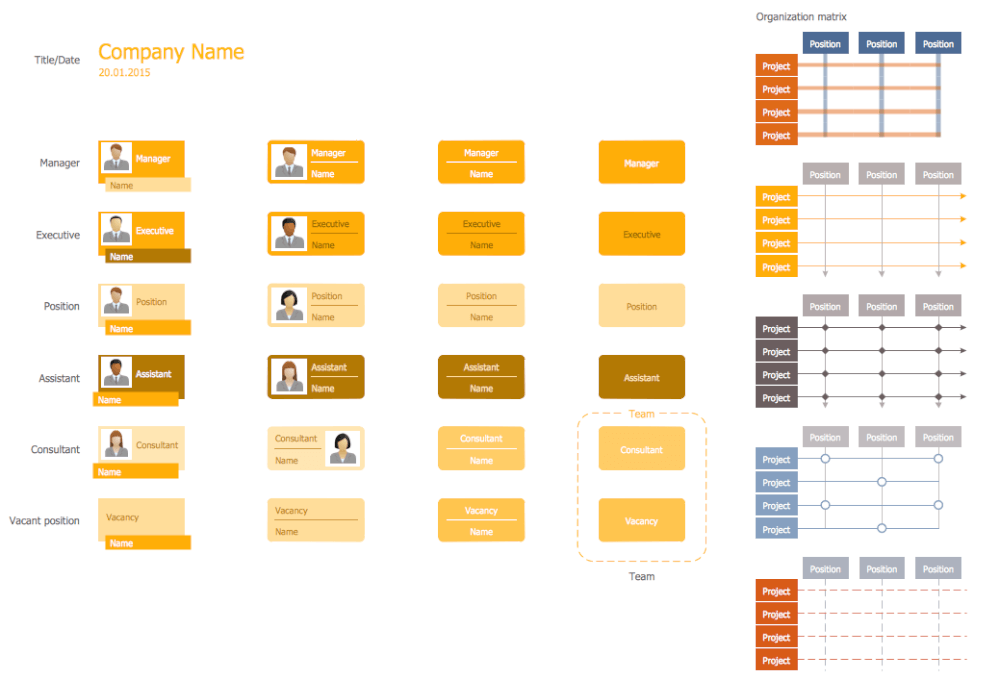
Design Elements — Organizational Chart (people)
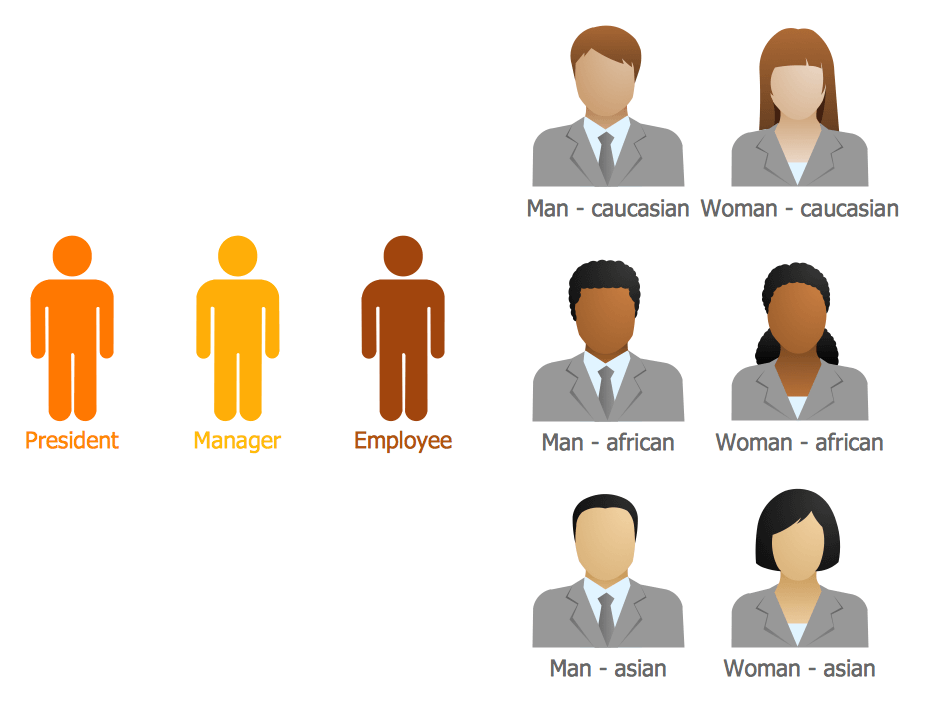
Orgcharts Examples
There are a few samples that you see on this page which were created in the ConceptDraw DIAGRAM application by using the 25 Typical Orgcharts solution. Some of the solution's capabilities as well as the professional results which you can achieve are all demonstrated here on this page.
All source documents are vector graphic documents which are always available for modifying, reviewing and/or converting to many different formats, such as MS PowerPoint, PDF file, MS Visio, and many other graphic ones from the ConceptDraw Solution Park or ConceptDraw STORE. The 25 Typical Orgcharts solution is available to all ConceptDraw DIAGRAM users to get installed and used while working in the ConceptDraw DIAGRAM diagramming and drawing software.
Example 1: Flat Organizational Chart
This diagram was created in ConceptDraw DIAGRAM using the Organizational Chart (people) library from the 25 Typical Orgcharts solution. An experienced user spent 5 minutes creating this sample.
The world is still flat, according to this theory of organization. Some companies structure themselves so that there is little space between the top and bottom levels of management, which allows greater collective input on the decision making process. Using the 25 Typical Orgcharts solution, you can easily illustrate this process and quickly create complex flat organizational structure charts.
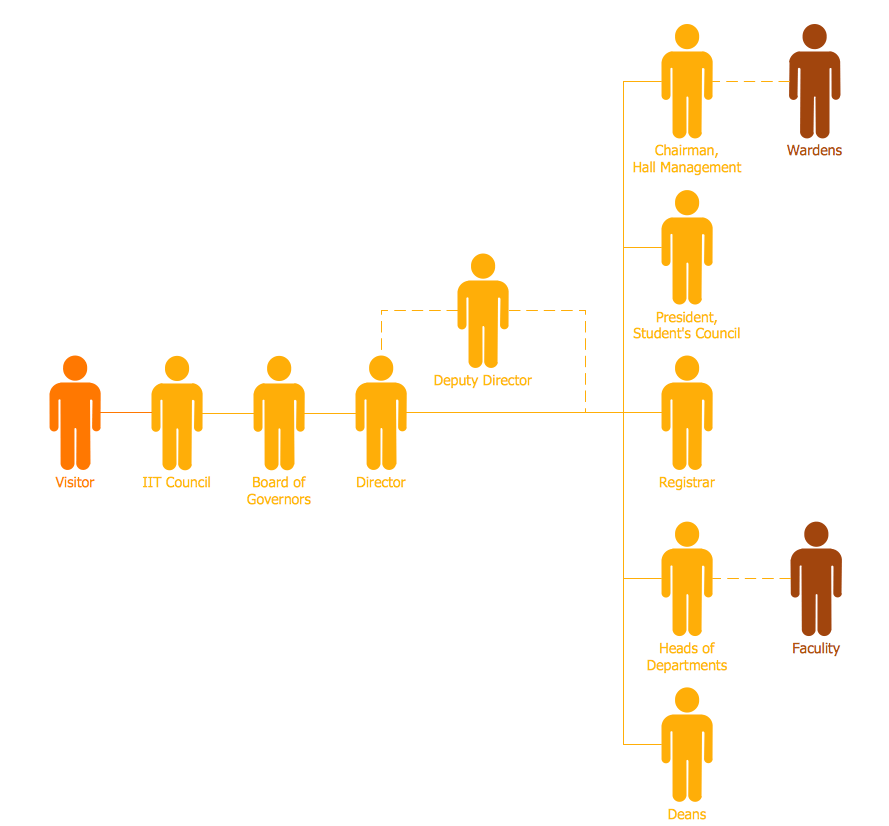
Example 2: Hierarchical Organizational Chart
This diagram was created in ConceptDraw DIAGRAM using the Organizational Chart library from the 25 Typical Orgcharts solution. An experienced user spent 10 minutes creating this sample.
A Hierarchical structure has a more defined order of power, structuring a company like a pyramid from the highest level of management at the top, to the staff at the base. This hierarchical organization chart visually shows the division of departmental roles within a software company.
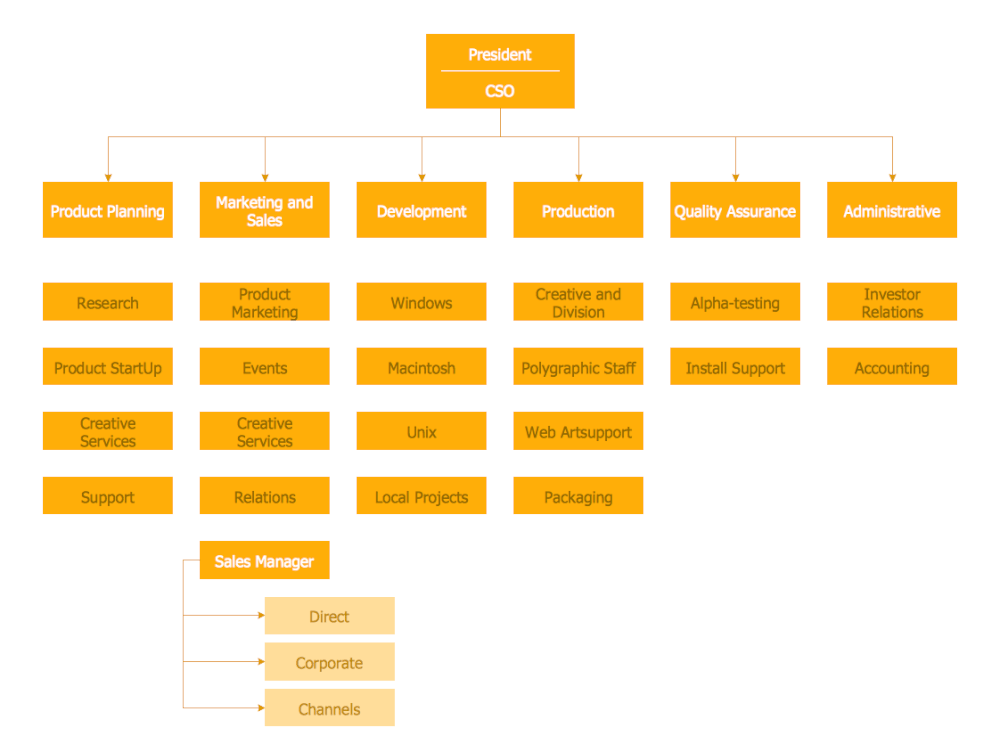
Example 3: Matrix Organizational Chart
This diagram was created in ConceptDraw DIAGRAM using the Organizational Chart library from the 25 Typical Orgcharts solution. An experienced user spent 10 minutes creating this sample.
The Matrix chart is needed to show the organization structure or business structure of a company that has a pool of cross functional employees, who might be involved in multiple processes with multiple managers at any one time. It's normally reserved for extremely large companies or events, such as the 2000 Sydney Olympics as shown on the matrix organization structure chart below.
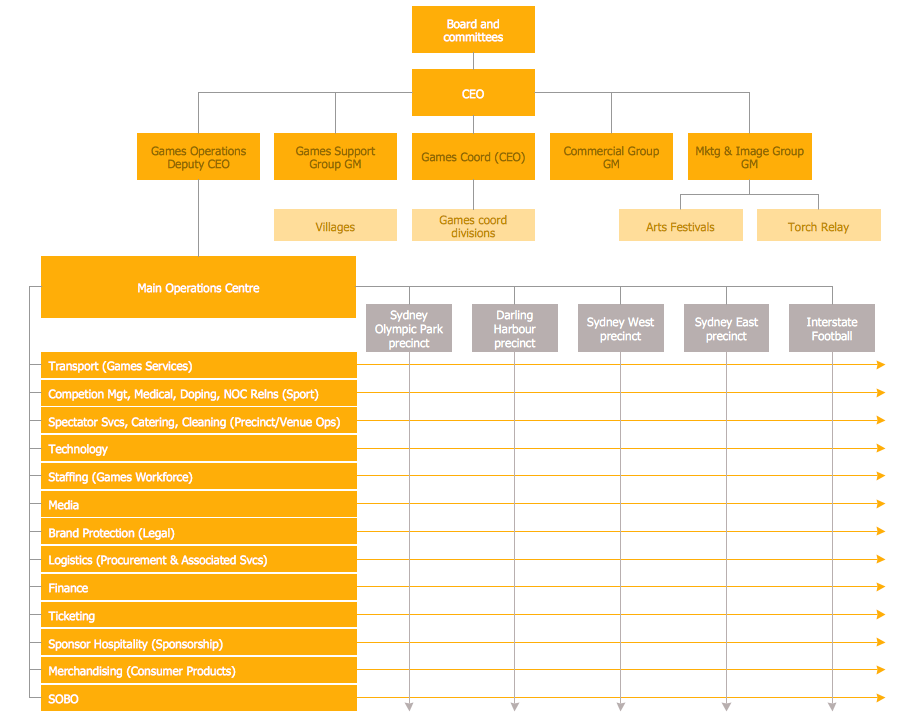
Example 4: DOE Organizational Chart
This diagram was created in ConceptDraw DIAGRAM using Organizational Chart library from the 25 Typical Orgcharts solution. An experienced user spent 15 minutes creating this sample.
Another company with a complex structure, the Department of Energy, is shown clearly and effectively on this chart. Now you don’t need to be an artist to design professional looking business organizational structure charts, thanks to the 25 Typical Orgcharts solution paid add-on to ConceptDraw DIAGRAM
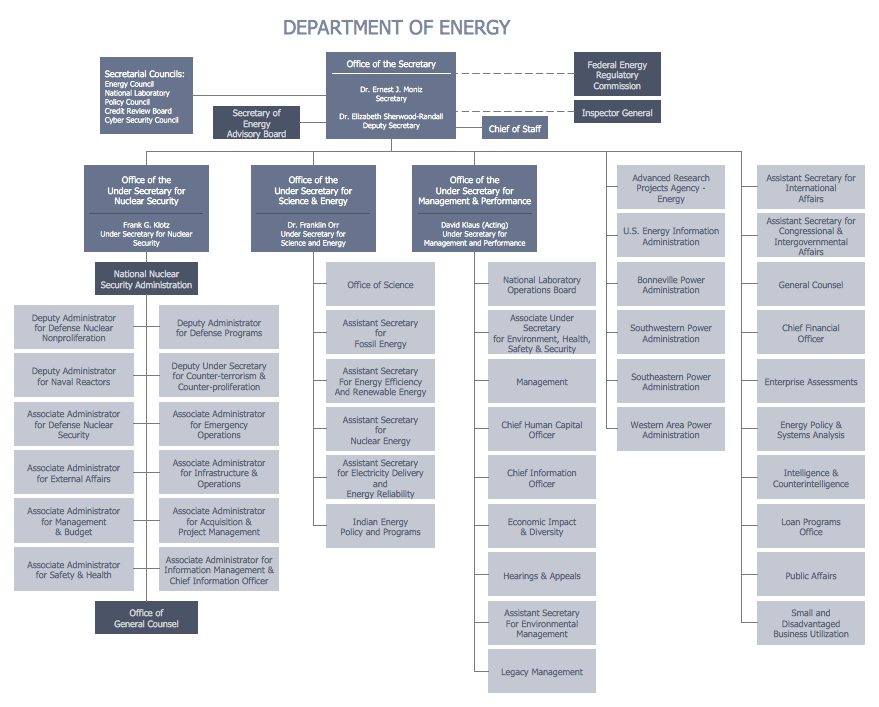
Example 5: Software Company Org Chart
This diagram was created in ConceptDraw DIAGRAM using the Organizational Chart library from the 25 Typical Orgcharts solution. An experienced user spent 10 minutes creating this sample.
How to make an organizational chart quickly and easily? ConceptDraw DIAGRAM software is the ideal org chart maker. The templates provided with the 25 Typical Orgcharts solution mean you can make an organizational management chart like the one below in a matter of moments.
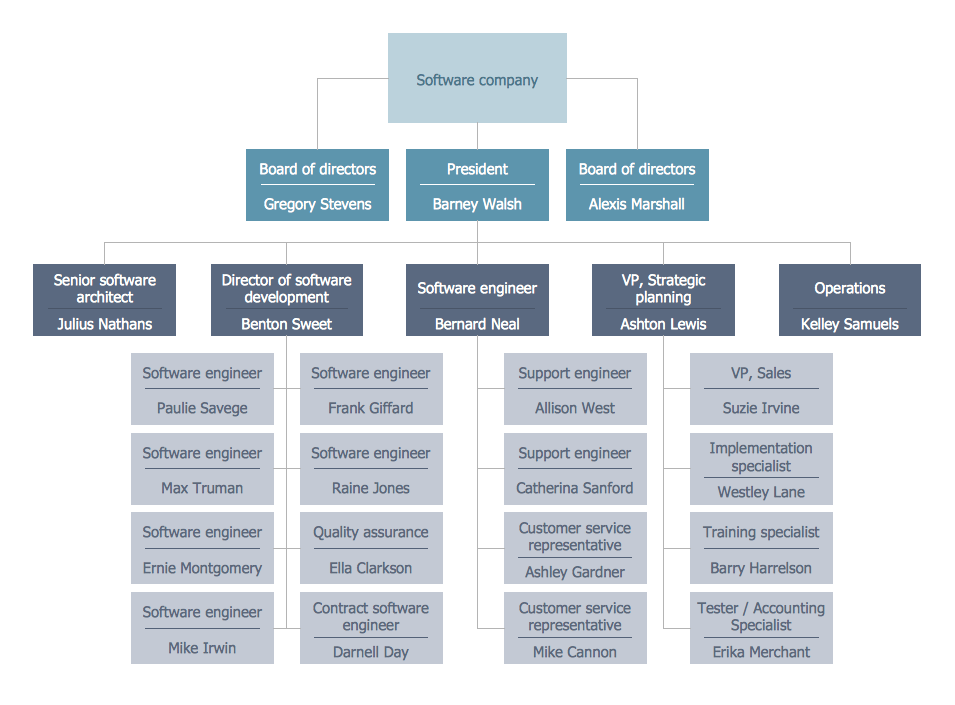
Example 6: Fort McPherson Org Chart
This diagram was created in ConceptDraw DIAGRAM using the Organizational Chart library from the 25 Typical Orgcharts solution. An experienced user spent 10 minutes creating this sample.
The levels of seniority are clearly defined on this organizational structure chart. Use the powerful 25 Typical Orgcharts solution with its two libraries of well thought-out vector shapes and icons to map out your companies power structure.
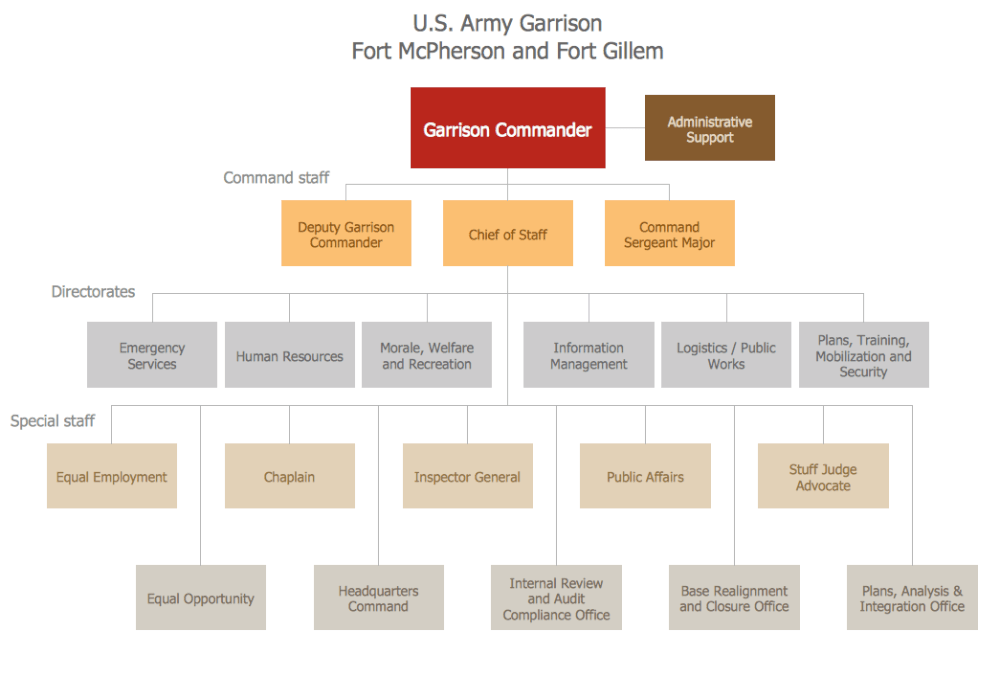
Example 7: US Navy Operating Forces Org Chart
This diagram was created in ConceptDraw DIAGRAM using the Organizational Chart library from the 25 Typical Orgcharts solution. An experienced user spent 10 minutes creating this sample.
Use the extensive drawing tools of 25 Typical Orgcharts solution to show the varying degrees of relationships within the management structure or corporate hierarchy, as shown on the chart below.
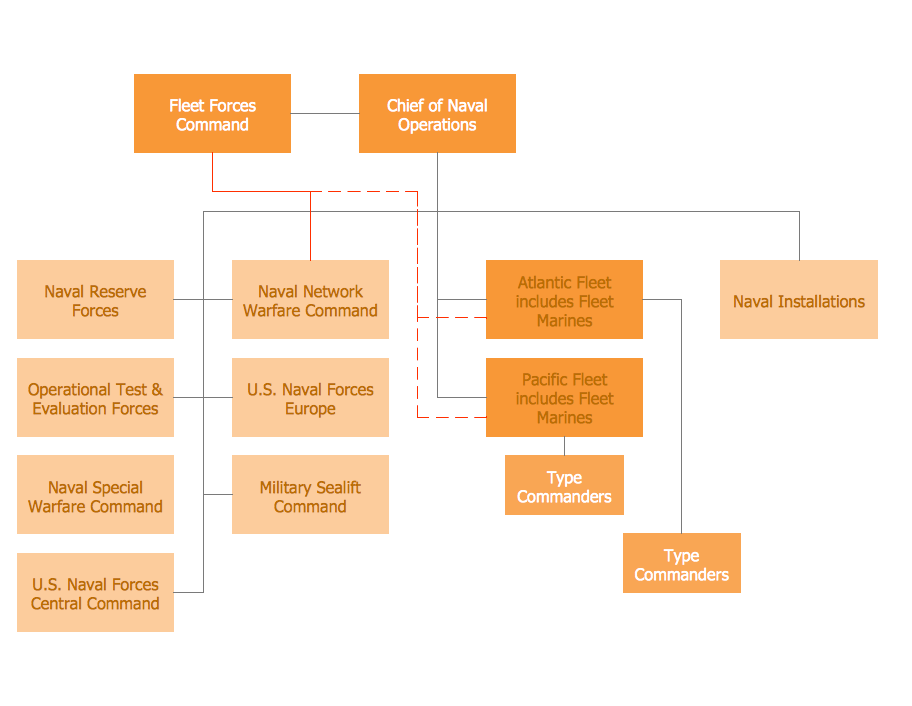
Example 8: Us Navy Shore Establishment Org Chart
This diagram was created in ConceptDraw DIAGRAM using the Organizational Chart library from the 25 Typical Orgcharts solution. An experienced user spent 10 minutes creating this sample.
The 25 Typical Orgcharts solution is effective for successful presentations; it allows you to present your view of the companies’ organizational structure in a concise and understandable format.

Example 9: US SECNAV Org Chart
This diagram was created in ConceptDraw DIAGRAM using the Organizational Chart library from the 25 Typical Orgcharts solution. An experienced user spent 10 minutes creating this sample.
Organizational structure types of charts such as organogram and organigram are widely used. ConceptDraw DIAGRAM gives you new opportunities when designing them. Typically there is a defined leader at the top of any company structure; you can effectively show its relationship with the company, as shown on this business organizational chart.

Example 10: WASO Org Chart
This diagram was created in ConceptDraw DIAGRAM using the Organizational Chart library from the 25 Typical Orgcharts solution. An experienced user spent 20 minutes creating this sample.
Using the graphics and icons contained within libraries of the 25 Typical Orgcharts solution allows you to create professional looking and detail-heavy charts such as the organizational chart examples presented on this page in just a few minutes. Make your organization charts creating easier and more convenient thanks to the specially developed 25 Typical Orgcharts solution.
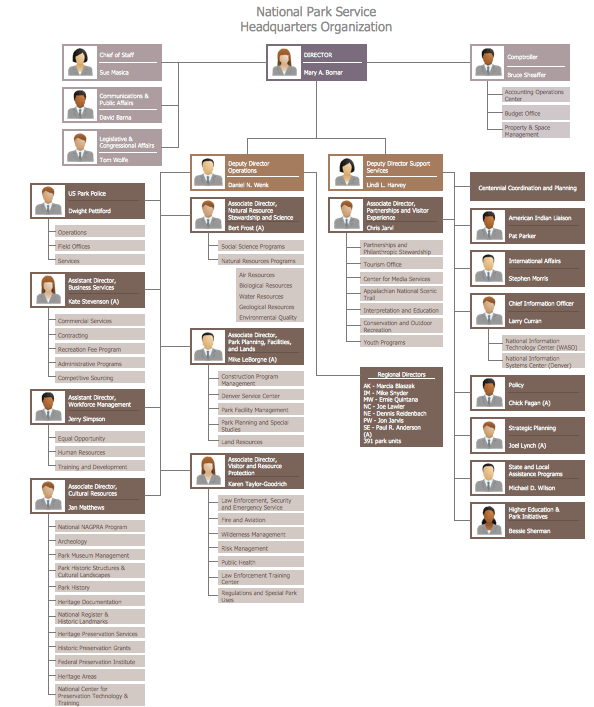
More Examples and Templates

Flat Org Chart Template 1

Flat Org Chart Template 2

Flat Org Chart Template 3

Flat Org Chart Template 4

Flat Org Chart Template 5

Hierarchical Org Chart Template 1

Hierarchical Org Chart Template 2

Hierarchical Org Chart Template 3

Hierarchical Org Chart Template 4

Hierarchical Org Chart Template 5

Hierarchical Org Chart Template 6

Hierarchical Org Chart Template 7

Hierarchical Org Chart Template 8

Hierarchical Org Chart Template 9

Hierarchical Org Chart Template 10

Hierarchical Org Chart Template 11

Hierarchical Org Chart Template 12

Hierarchical Org Chart Template 13

Hierarchical Org Chart Template 14

Hierarchical Org Chart Template 15
Inside
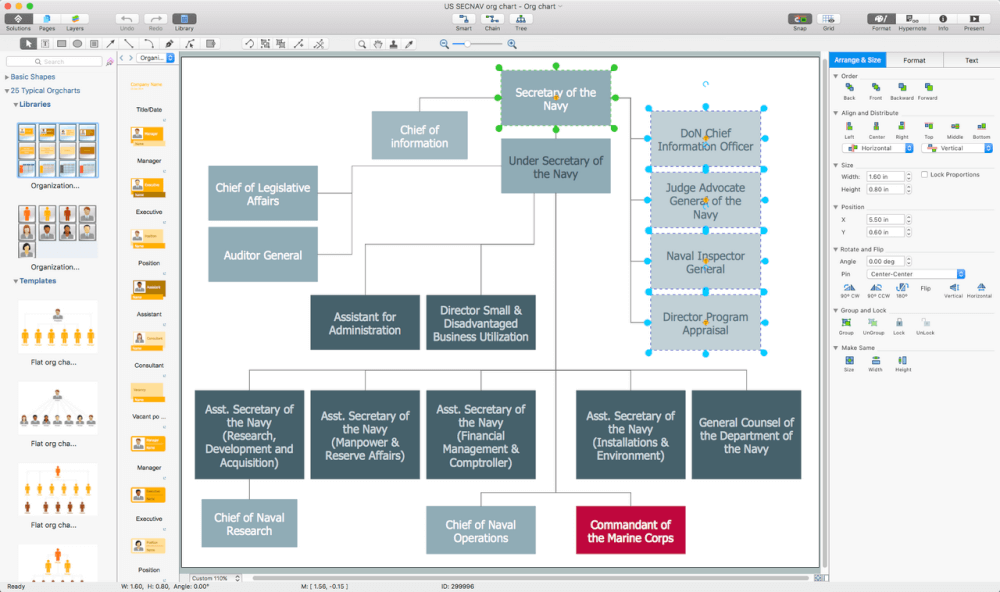
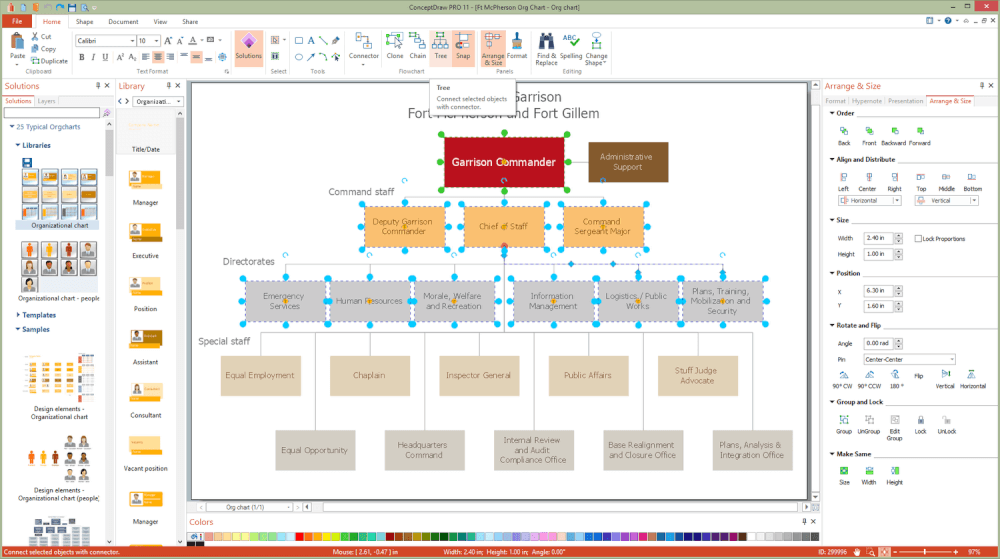
What I Need to Get Started
After ConceptDraw DIAGRAM is installed, the 25 Typical Orgcharts solution can be purchased either from the Management area of ConceptDraw STORE itself or from our online store. Thus, you will be able to use the 25 Typical Orgcharts solution straight after.
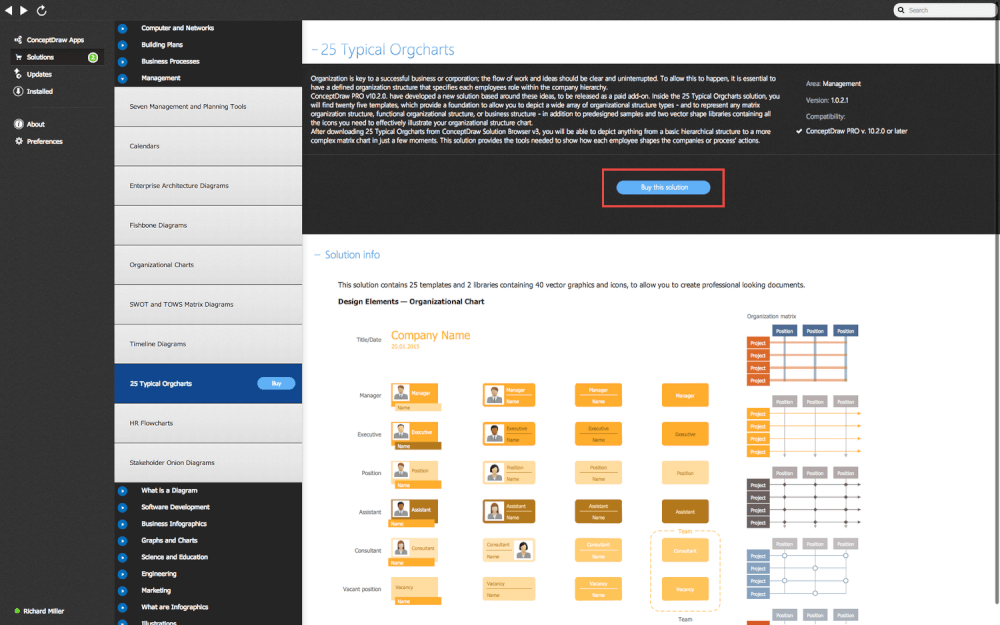
How to install
First of all, make sure that both ConceptDraw STORE and ConceptDraw DIAGRAM applications are downloaded and installed on your computer. Next, install the 25 Typical Orgcharts solution from the ConceptDraw STORE to use it in the ConceptDraw DIAGRAM application.
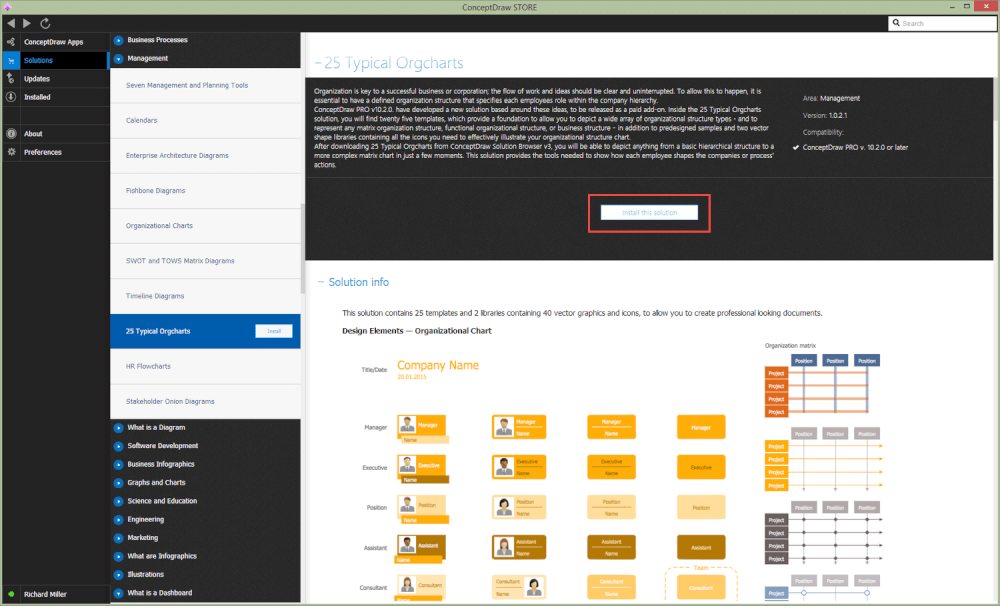
Start using
Start using the 25 Typical Orgcharts solution to make the professionally looking business planning diagrams by adding the design elements taken from the stencil libraries and editing the pre-made examples that can be found there.
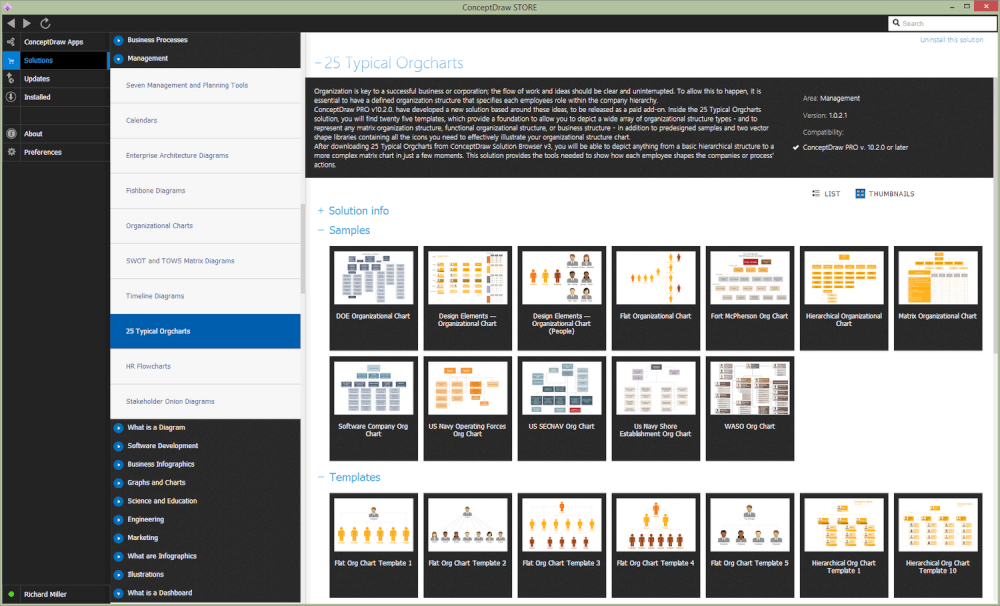
Types of Organizational Structures
Organization Structure Types
The three main types of organizational structure are as follows: hierarchical, flat, and matrix. A smaller company, or one with few levels of middle management, might have a more organic structure — there is a shared knowledge base and centralized decision making; all parts of the workforce have common interaction with each other. But in a larger company made up of various divisions and teams, who may have only brief interactions and essentially work independently from each other, it is crucial to have a structure in place that clearly defines the decision making and supervisory process.

Hierarchical Organization Structure
Perhaps the most common form of organizational structure is hierarchical. This structure can be represented as a pyramid, with a single entity in authority at the top, with subsequent levels of power beneath them. Each member of the pyramid reports only to their direct subordinates or superiors, limiting the amount of communication overhead, which can be seen both as an asset or a limitation. It is easy to see where a hierarchical structure would be an effective solution; companies that have offices based in disparate locations, a business that focuses on diversified markets, any organization with need for multiple levels of middle management.

Flat Organization Structure
A flat organizational structure differs from a hierarchical one by almost entirely dispensing with middle management; rather than a pyramid, there is a 'flat' layer between staff and executives. In real terms, this means that almost all staff are involved in the decision making process and produce reports centrally — it can be viewed as a typically democratic structure.

Matrix Organization Structure
A third form of organizational structure can take the form of a matrix. This structure is commonly found in businesses that have more than one line of reportage. For instance, a company might contain an engineering department with engineering managers who workers report to. However, these workers might also have to liaise with different product or project managers depending on current tasks. Some form of matrix organization is found in most large-scale modern businesses.





